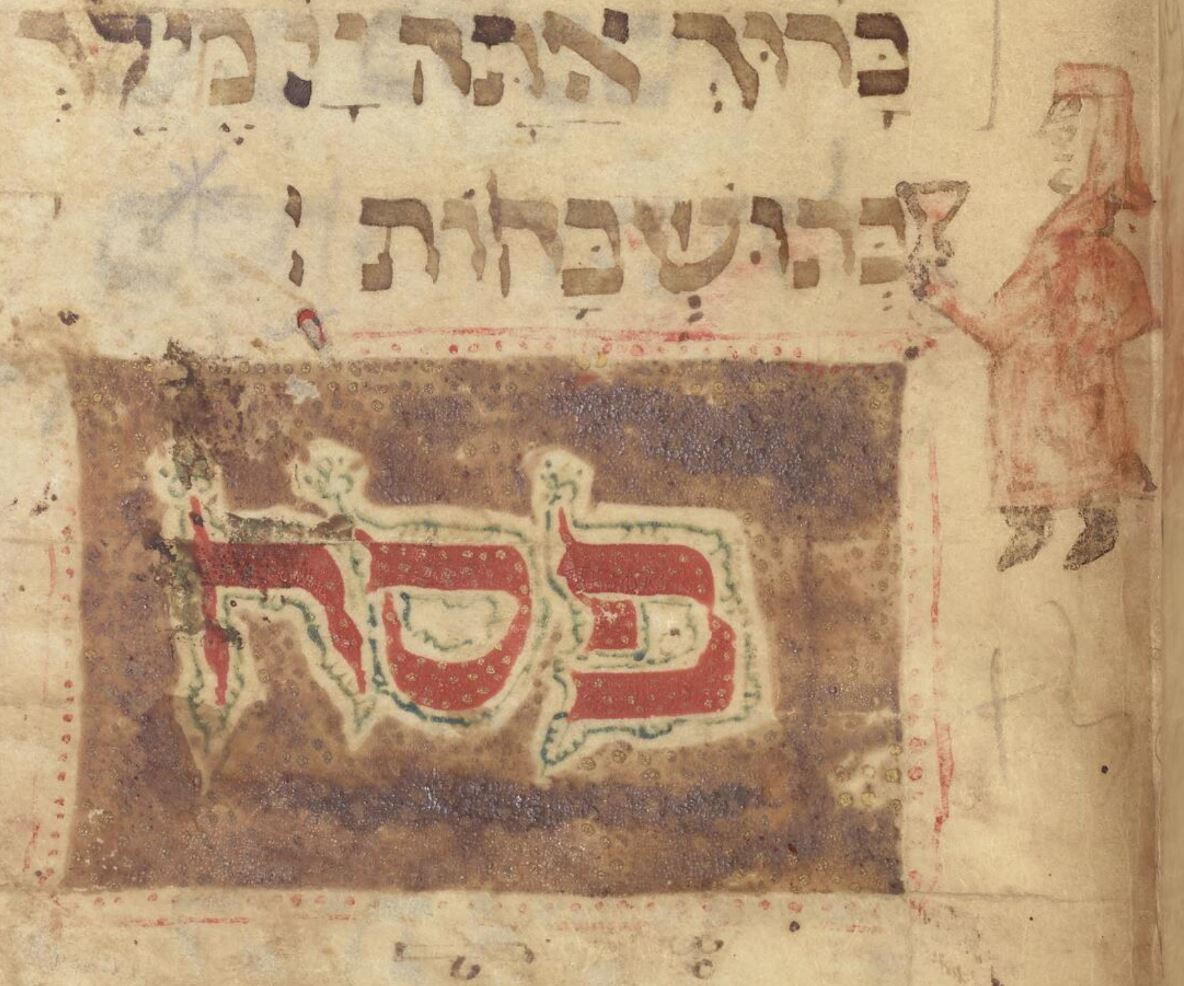It is Passover. And this is the Rylands Library’s blog. Have you heard of the famous Rylands Sephardi Passover Haggadah? No, this blog is not about it. This blog is about our other beautiful and fascinating Haggadot. The Rylands has a fine collection of these guide books containing prayers and readings recited during the Seder meal on the eve of Passover. Come and browse!
Our oldest illustrated Haggadah



Perhaps our earliest Haggadah manuscript in a separate volume is a thin little book from the early fourteenth century (Hebrew MS 29). It did not survive in its entirety. A large part of its beginning is missing, and the text starts from the section corresponding to the drinking of the third cup of wine within Birkat ha-Mazon (Grace after meal). Colourful initial-panel words give this manuscript a distinctive look. Some of these have more than geometrical and floral motifs: they are surrounded by the most curious-looking hybrids including a merman.



There are also a handful of marginal illustrations, some clearly related to Passover, like a cup of wine (Psalms 118) and the little figure holding a cup of wine at the beginning of the liturgical poem Pesah Mitsraim (Passover in Egypt).

At the beginning of the Hallel (the Psalms of Praise), beginning “Pour out your wrath” (Shefokh hamatkha), we can see the remains of a figure with a fancy headgear. Due to damage to the page, it is not possible to see exactly what the figure is doing. Is he pouring out something from a bucket just like in the Barcelona Haggadah? Or is he lifting a cup of wine like in the London Ashkenazi Haggadah? Or is he perhaps riding a donkey?



The Ashkenazi Rylands Haggadah
In Ashkenazi Haggadah manuscripts at this part of the text you often find a depiction of the Messiah on the back of a donkey. This is exactly what we encounter in the so-called Rylands Ashkenazi Haggadah (Hebrew MS 7). Here the Messiah followed by a large crowd is approaching the gates of a city. Where does this iconography come from? The full answer is beyond the limits of this blog. Briefly, the recitation of the biblical passage “Pour out your wrath upon the nations that do not recognise You” (Psalms 79:6) was not part of the Haggadah originally. It appears first in the eleven-century Mahzor Vitry. In time, a special ritual became connected to this introductory verse of the Hallel: when this text is read someone among the participants at the Seder opens the door of the house. This ritual symbolises the faith in the coming of the Messiah.

Let’s see one more composition from among the many fascinating images of this Haggadah: the curious case of the sextuplets. This miniature illustrates the biblical quotation from Exodus ‘and the Israelites multiplied and increased very greatly, so that the land filled with them.’ (Exodus 1:7). How could the Israelites multiply when the Egyptians treated them so badly? Early Jewish biblical commentaries (midrashim) provide the answer: the Israelites multiplied because each Israelite woman would give birth to six children at once. The commentary in the outer margin of the same page cites this interpretation and reads as follows: ‘it is taught that each woman gave birth to six children … ’.

After Pharaoh gave orders to kill every new-born boy (Exodus 1:15-22), the Israelite women went out onto the fields to give birth in secret. Having given birth to their sextuplets, they then had to return to their houses lest the Egyptians became suspicious. The new-born babies were left alone on the field and God himself or his angels took care of them. The naked figures playing in the meadow may well be these children. And you can find many more intriguing illustrations in the Rylands Ashkenazi Haggadah!
The Rylands Leipnik Haggadah
Jewish manuscript production did not cease after the invention of the printing. Far from it. The eighteenth century witnessed a spectacular revival of Hebrew book illumination. The Rylands holds a beautifully illustrated eighteenth-century Passover Haggadah copied by the famous Jewish scribe and illustrator Joseph ben David of Leipnik in Hamburg-Altona (Hebrew MS 39). Joseph also started on the illustrations but then the manuscript was bought by an Englishman, presumably an aristocrat collector, and brought to England unfinished. The work was finished here in a very different style by an Christian painter who sometimes misinterpreted the iconographical models he consulted. If you wish to learn more about this curious story, read our blog about the Leipnik Haggadah here.


The first six steps of the Seder painted by Joseph Leipnik, Manchester Leipnik Haggadah, Manchester, JRL, Hebrew MS 39, folio 2b (left); The Israelites going down to Egypt painted by a Christian painter, Manchester Leipnik Haggadah, Manchester, JRL, Hebrew MS 39, folio 11b (right)
Haggadot within prayer books
We also hold prayer books that include the text of the Passover Haggadah. Look at for instance Yemenite Tikhlal that was copied in Sanaʿa in 1769 (Gaster Hebrew MS Add 5) written in Judeo-Arabic and Hebrew. The texts in this manuscript are accompanied by Isaac Wanneh Yemenite kabbalist’s commentary Paʿamon Zahav ṿe-Rimon (Golden Bell and Pomegranate). Although this codex is not decorated or illustrated, the layout of the pages with the neat hierarchy of scripts is a delight to look at!

And If you are interested in more liturgical codices containing the Passover Haggadah, check out these:
Hebrew MS 53: Siddur from 16th-century Persia, with the Passover Haggadah see from page 13;
Gaster Hebrew MS 2042: early modern Yemenite Tikhlal, with the Passover Haggadah on folios 52a-61b;
Gaster Hebrew MS 2022: early 19th-century Yemenite Tikhlal with the Passover Haggadah on folios 8a-32b.
Meet the Haggadot in person!
If you wish to see the illustrated Haggadot discussed in this blog, come and see them “in the flesh” at the Manchester Jewish Museum on 11 April 2023. For more details about this event, click here.


0 comments on “The Wonderful World of Passover Haggadot”